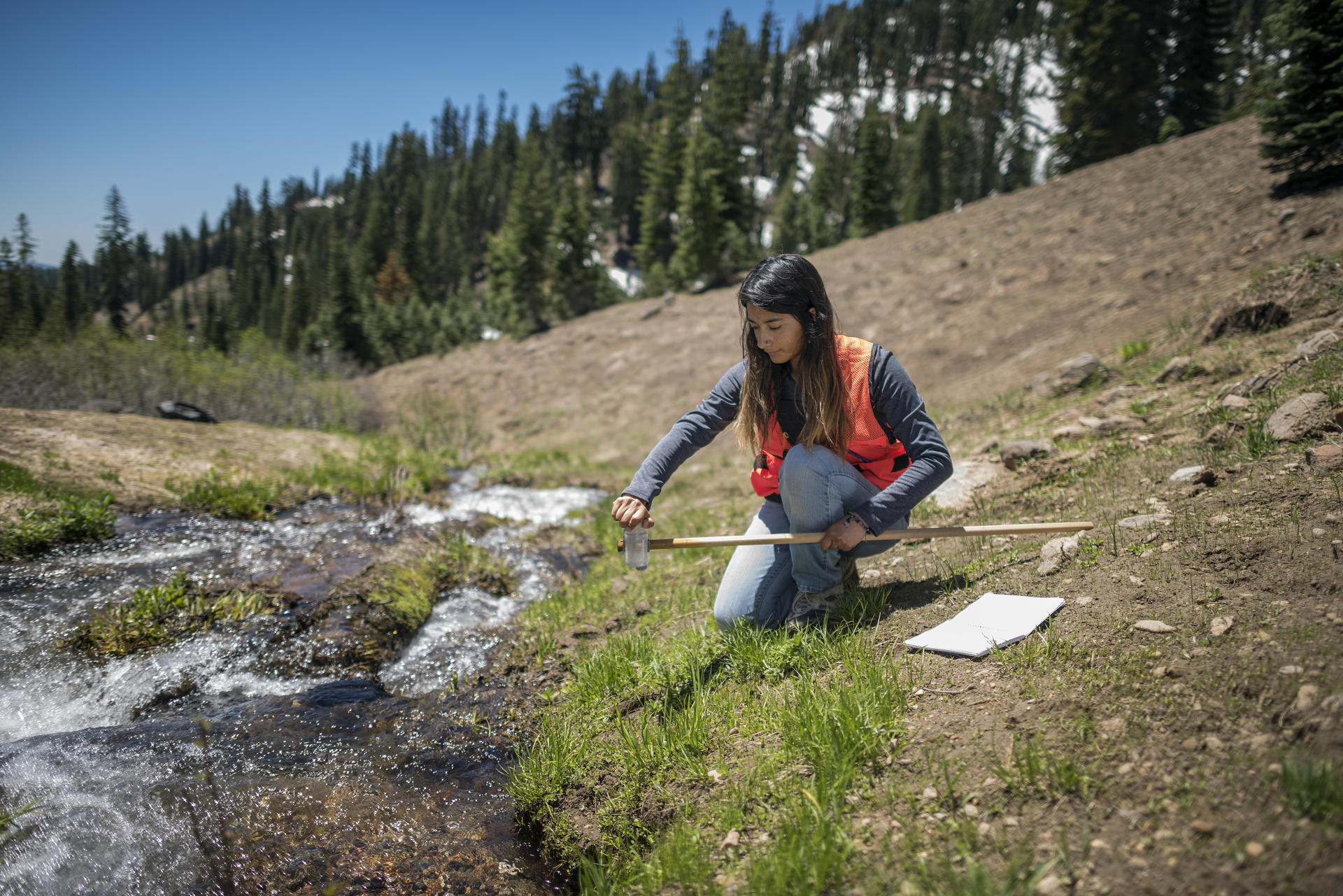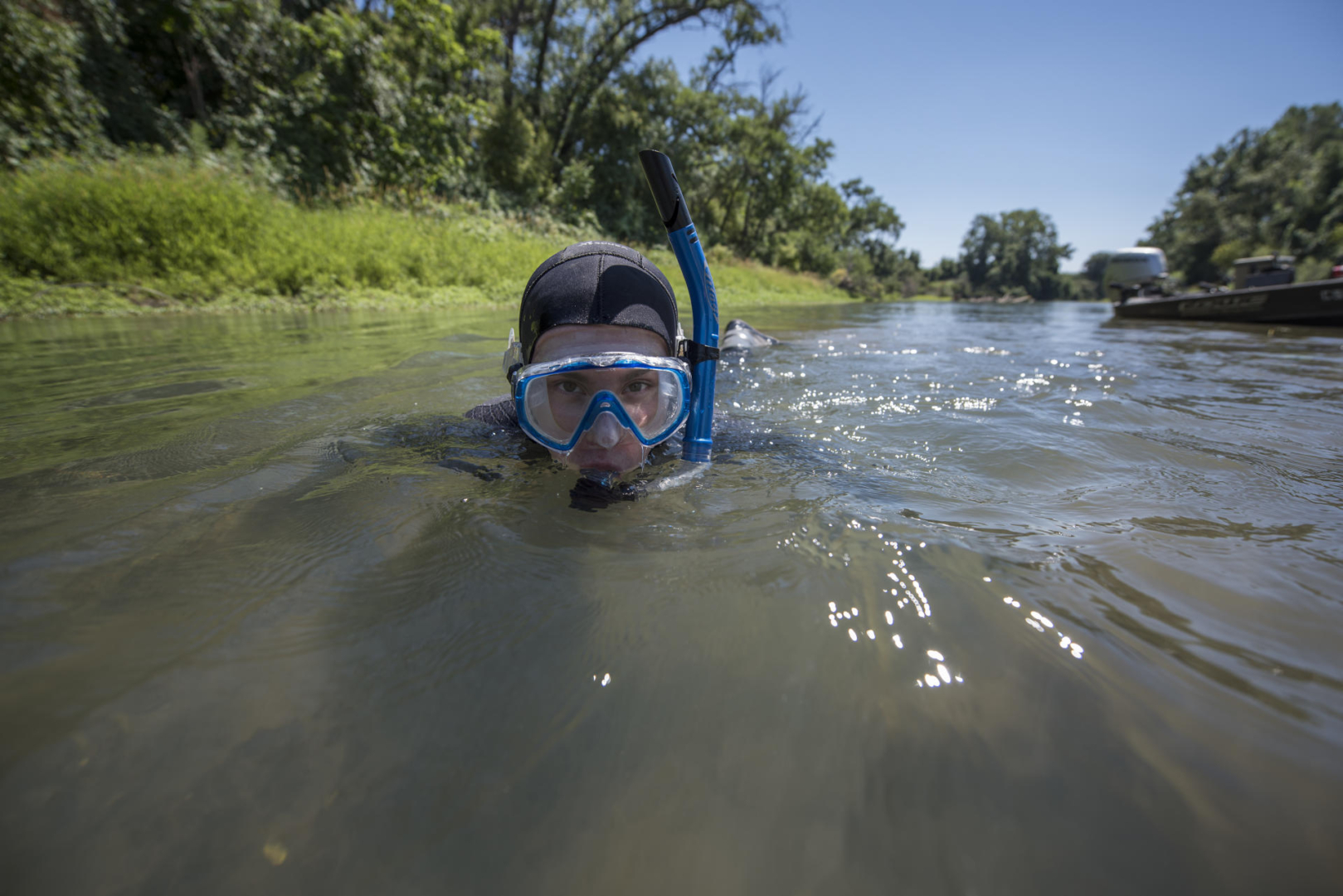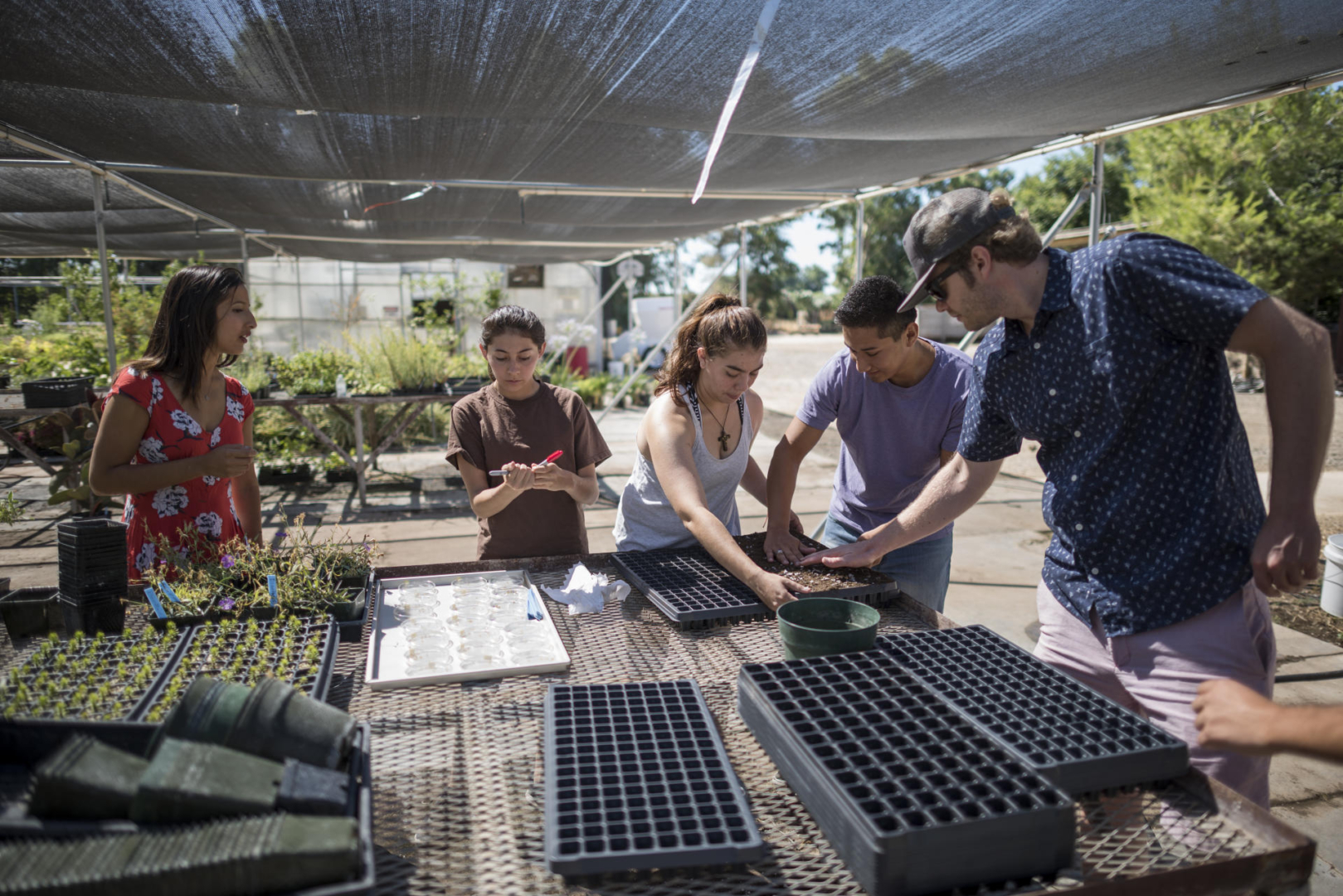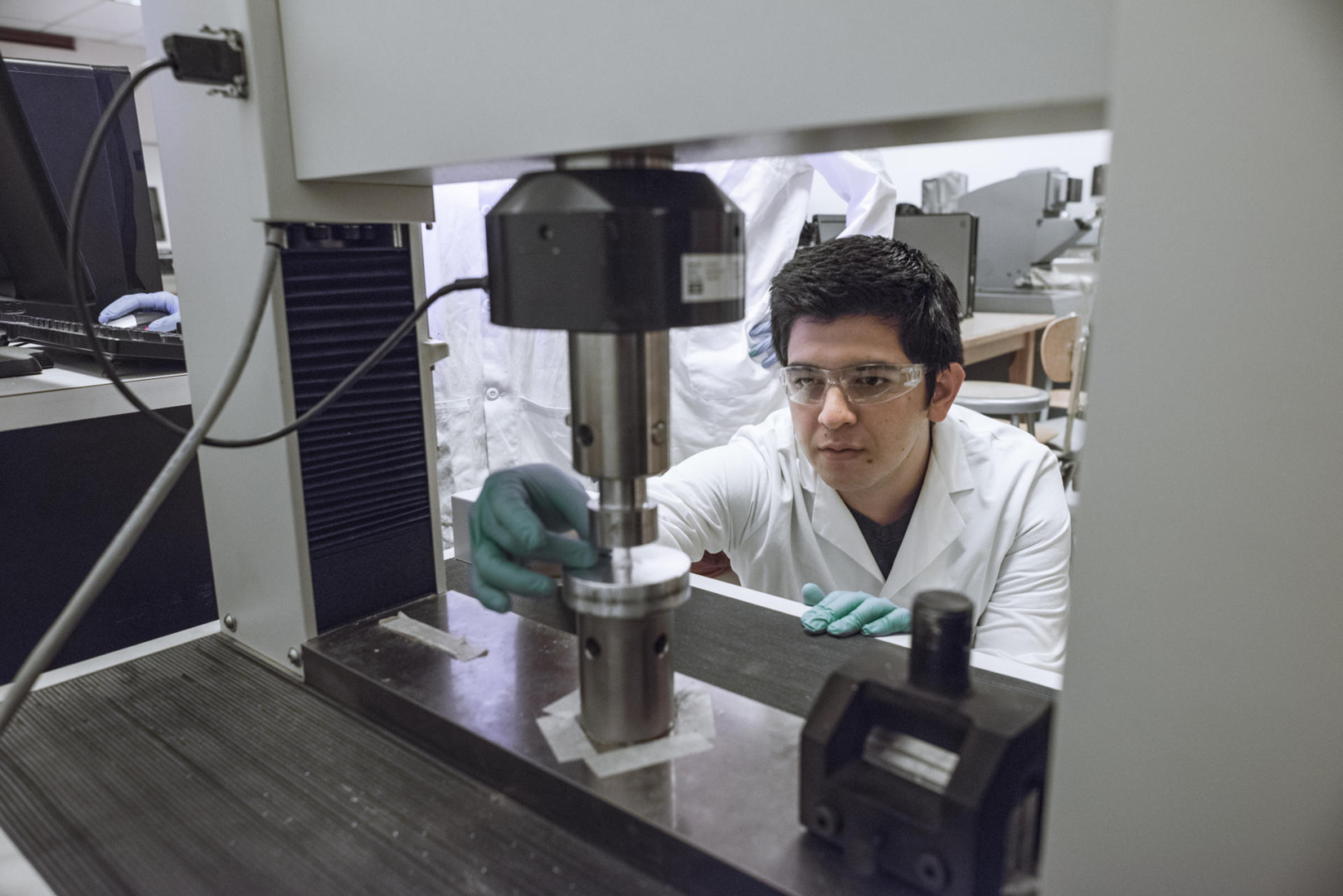Multimillion-Dollar Grants Ensure Hands-On Research Continues for STEM Students

Angelica Rodriguez collects water samples along various stream tributaries in the park as she works on her Chico STEM Connections Collaborative (CSC2) summer research project, monitoring hydrothermal water temperature and composition at the Lassen Volcanic National Park on Monday, June 26, 2017 in Mill Creek, Calif. This process involves using a multimeter to analyze stream water, and collecting samples using an extendable water collection arm. (Jason Halley/University Photographer)
Consuelo Baez Vega doesn’t mind getting her hands dirty—both figuratively and literally.
In 2020, the first-generation student paired up with College of Agriculture faculty Ana Medic at the University Farm for a research project studying weed management in fava bean beds through the Chico STEM Connections Collaborative (CSC2). The collaborative, which provides supportive services and experiences to students identifying as low-income or Hispanic who enroll in majors where they have typically been underserved, has offered paid research opportunities funded by a Title III grant since 2016.
For several hours each week, Vega would meet up with Medic at the farm and they would test different types of weed management practices (depth of seed planting, herbicides or no herbicides, for example) and the optimum number of treatments for a healthy fava bean bed. Though the in-person aspect of Vega’s research was cut short by the pandemic midway through the semester, the agriculture major said she received invaluable first-hand research experience as an undergraduate—while also earning a student stipend for her work.
“The financial help greatly benefited me in helping me get the things I need,” said Vega, a senior. “I didn’t have to worry too much about the financial aspect so I could focus more on my studies.”
Now, CSC2 has ensured that these hands-on research opportunities will continue over the next five years—the Colleges of Agriculture, Natural Sciences, and Engineering, Computer Science, and Construction Management were recently awarded a pair of grants totaling more than $7.5 million over the next five years. The timing could not have been better, as the timeline for the original funds were about to run their course.
“We went from zero to $3 million, then added another $5 million for $8 million in grants and support,” said Paul Villegas, who oversees the MESA Engineering Program. “Not a bad week.”

Villegas was director of Chico State’s original Title III STEM grant in 2016 when the University received designation as a Hispanic-Serving Institution (HSI). Earlier this year, Villegas and Lupe Jimenez, associate director of the MESA Engineering Program, began pursuing additional funding to continue STEM-related research opportunities.
Securing the grants was truly a team effort. After weekends and late nights from Jimenez and then-CSC2 Mentor Coordinator JoAna Brooks—she is currently project director for the CEMUR Project—and help from Latinx Equity and Success Director Teresita Curiel, the University was awarded two collaborative grants that will benefit multiple colleges and scientific disciplines. The University received a five-year, $2.79 million Title V Developing Hispanic-Serving Institutions (DHSI) Program grant. Separately, a five-year, $4.99 million Title III HSI STEM grant was awarded to benefit CSC2.
These funds are investments in Chico State students, their research, and their futures, Villegas said, adding that their most robust and in-depth educational opportunities come when they pair up with faculty for undergraduate research.
“We never used to look like a research institution, and now we have all of these events happening every summer,” Villegas said. “It’s a definite win-win situation, and quite honestly, it’s changed the culture of our campus.”
From collecting and monitoring water samples in Lassen Volcanic National Park to studying aerodynamics of airfoils and wind tunnel characterization to counting fish species in the Sacramento River, Chico State students have participated in research projects that have challenged and engaged them.
While Vega’s experience with Medic solidified her interest in research—it also led directly to a current paid research position in Biggs with University of California, Davis—Villegas said teaming up with faculty can often fine-tune a student’s broader in-class interest in a particular field.
“A lot of times students don’t see what the discipline looks like early on and they may lose interest,” he said. “But if they learn about applying activities in their actual discipline, they turn around and say, ‘Oh, I see how this relates to what I’m doing in the classroom.’”

Access to such opportunities is how Rigoberto Vazquez (Mechanical Engineering, ’19) harnessed a lifelong interest in math and science. As an undergraduate student, the MESA program afforded him the opportunity to conduct research with Ozgul Yasar, assistant professor from the Department of Mechanical and Mechatronic Engineering and Advanced Manufacturing. Together, they worked to design and engineer scaffolds to grow tissues for organ transplantation.
“Initially, I wasn’t too interested in that kind of research,” Vazquez recalled. “But doing it sparked something in me and I wanted to pursue more.”
The work with Yasar was a springboard. Since graduating, Vazquez earned his master’s degree last spring in nuclear engineering and radiological science from the University of Michigan, where he was also honored as a Commencement speaker. Today, he is working on his PhD in biomedical engineering at Cornell University.
“Something about that project with Dr. Ozgul motivated me,” he said. “It piqued my interest to a point where I wanted to pursue it more in grad school—it was actually very enlightening for me.”
Vega, who is focusing her major in crops, horticulture, and land resource management, strongly recommends students pursue research opportunities through CSC2, as they can offer a glimpse into what a future master’s program might look like.
“It opens up your eyes to the ways that we find answers to things, it’s a process of data collection, finding patterns, seeing which one works the best, or why it didn’t work the best in whatever research the students are doing,” she said. “It also opens students up to asking themselves what do they want to do, and who’s the mentor they want.”
College of Agriculture Associate Dean Patrick Doyle said having a system in which the University’s three science-based colleges work collaboratively can create organic and valuable learning opportunities.
“It’s really fun to see the students in the programs supporting each other, like when a student from the College of Ag asks an engineering student or a natural science student about their research, and vice versa,” he said. “A lot of cross-learning happening, and that’s a bonus to the whole program.”

And when a student receives their diploma and is ready to take on bigger challenges, Doyle said it puts into perspective why the University makes those investments.
“When I see a student develop, put their head down and do the work—especially those that find graduate school—it’s a great experience to see them go on to something that they may never thought about doing before,” he said. “It’s closing one chapter and seeing the beginning of another—it’s what we do, it’s why we’re here.”
Both grants fund academic support, creation of HSI STEM endowments, student financial literacy education, and dozens of undergraduate research opportunities, which include student stipends—$5,000 for the Title III grant and $4,500 for the Title V grant—and a $500 financial allotment for student research materials.
Additionally, the Title III grant earmarks funds to strengthen community college transfer support and has created an endowment through the STEM college collaborative. And the Title V grant will also develop new professional development coordinator and industry/alumni coordinator staff positions within the College of ECC, creating additional touchpoints for students while they are at Chico State and preparing them for the workforce.
Students interested in pursuing research opportunities funded by these grants can email Lupe Jimenez at ljimenez@csuchico.edu.


